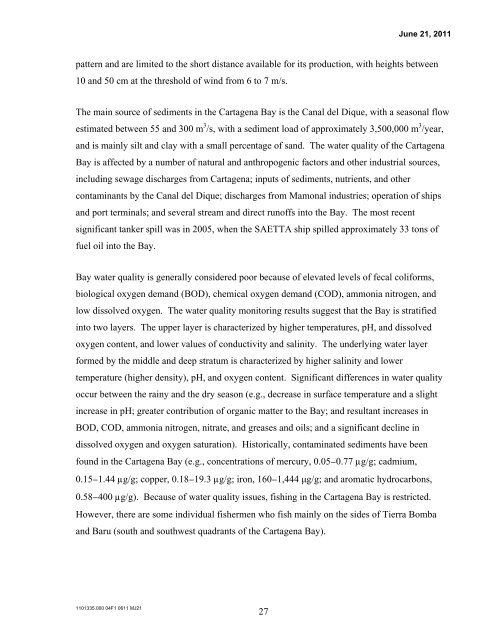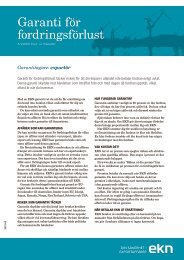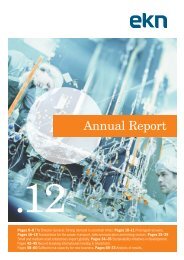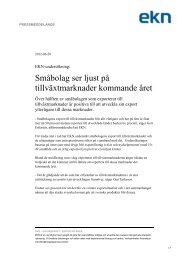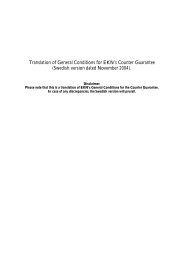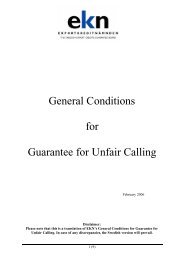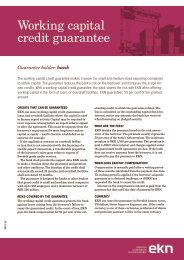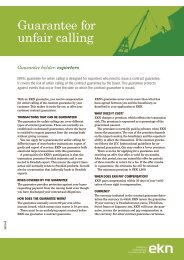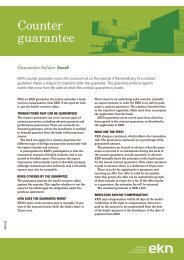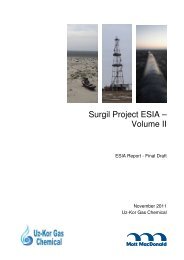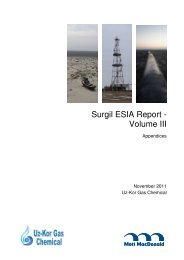Reficar Cartagena Refinery Expansion, Colombia - EKN
Reficar Cartagena Refinery Expansion, Colombia - EKN
Reficar Cartagena Refinery Expansion, Colombia - EKN
Create successful ePaper yourself
Turn your PDF publications into a flip-book with our unique Google optimized e-Paper software.
1101335.000 04F1 0611 MJ21<br />
27<br />
June 21, 2011<br />
pattern and are limited to the short distance available for its production, with heights between<br />
10 and 50 cm at the threshold of wind from 6 to 7 m/s.<br />
The main source of sediments in the <strong>Cartagena</strong> Bay is the Canal del Dique, with a seasonal flow<br />
estimated between 55 and 300 m 3 /s, with a sediment load of approximately 3,500,000 m 3 /year,<br />
and is mainly silt and clay with a small percentage of sand. The water quality of the <strong>Cartagena</strong><br />
Bay is affected by a number of natural and anthropogenic factors and other industrial sources,<br />
including sewage discharges from <strong>Cartagena</strong>; inputs of sediments, nutrients, and other<br />
contaminants by the Canal del Dique; discharges from Mamonal industries; operation of ships<br />
and port terminals; and several stream and direct runoffs into the Bay. The most recent<br />
significant tanker spill was in 2005, when the SAETTA ship spilled approximately 33 tons of<br />
fuel oil into the Bay.<br />
Bay water quality is generally considered poor because of elevated levels of fecal coliforms,<br />
biological oxygen demand (BOD), chemical oxygen demand (COD), ammonia nitrogen, and<br />
low dissolved oxygen. The water quality monitoring results suggest that the Bay is stratified<br />
into two layers. The upper layer is characterized by higher temperatures, pH, and dissolved<br />
oxygen content, and lower values of conductivity and salinity. The underlying water layer<br />
formed by the middle and deep stratum is characterized by higher salinity and lower<br />
temperature (higher density), pH, and oxygen content. Significant differences in water quality<br />
occur between the rainy and the dry season (e.g., decrease in surface temperature and a slight<br />
increase in pH; greater contribution of organic matter to the Bay; and resultant increases in<br />
BOD, COD, ammonia nitrogen, nitrate, and greases and oils; and a significant decline in<br />
dissolved oxygen and oxygen saturation). Historically, contaminated sediments have been<br />
found in the <strong>Cartagena</strong> Bay (e.g., concentrations of mercury, 0.05−0.77 µg/g; cadmium,<br />
0.15−1.44 µg/g; copper, 0.18−19.3 µg/g; iron, 160−1,444 μg/g; and aromatic hydrocarbons,<br />
0.58−400 µg/g). Because of water quality issues, fishing in the <strong>Cartagena</strong> Bay is restricted.<br />
However, there are some individual fishermen who fish mainly on the sides of Tierra Bomba<br />
and Baru (south and southwest quadrants of the <strong>Cartagena</strong> Bay).


